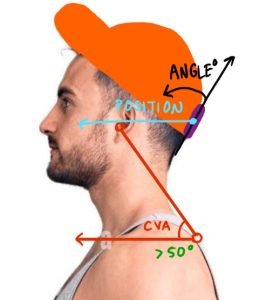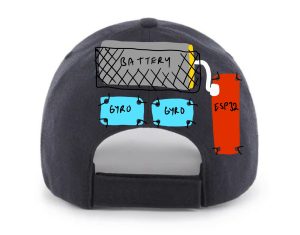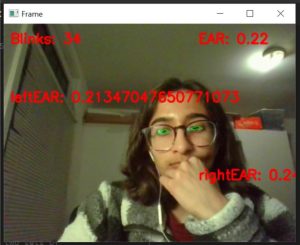PART A (Cora)
In regards to health, StrainLess has the potential to improve peoples physiological health. It is well established in the medical community that poor posture causes back pain and that staring at a screen for extended periods of time causes eye strain. With StrainLess, users receive an alert when they are exhibiting poor posture/eye strain which remind them to correct their posture and/or take a break from their screen which builds healthier habits and will therefore help them feel physically better. Psychologically, physically feeling better helps people have a better mood. Especially with things like chronic back pain and headaches associated with prolonged computer usage, which can negatively impact peoples’ emotional wellbeing. In regards to safety, StrainLess will be built with the user’s safety in mind. Specifically, we are ensuring that the electronics are safe and do not get too hot and burn the user’s skin by testing our product. We also are using bluetooth for communication between devices to prevent cords from getting caught. In regards to welfare, StrainLess helps meet the basic needs of people living in modern society because for many people working 9-5 jobs they are sitting at a desk and this is our target demographic for StrainLess. StrainLess will help these people reduce their back pain and eye strain.
PART B (Kaitlyn)
StrainLess is meant for people across different organizations. Our product is meant to help anybody who works at desks for extended periods of time, whether that be office workers, gamers, college students, or anybody else. We want our product to be available to those people who have difficulty maintaining good habits while sitting at a desk. Our solution approach also attempts to be as affordable as possible, so more people can use our product. We also did not want our solution approach to have any negative social impacts. In order to achieve this, we are ensuring that there is no personal data being stored about the user, and that every individual user gets the same experience. We increased our weight range to ensure as many people as possible could use the pressure sensors, and chose a CV model which is trained on a very socially diverse data set in order to ensure accuracy in CV across the entire range of users.
PART C (Lilly)
With respect to economic factors, StrainLess can improve office productivity – and therefore revenue, hopefully – by reducing the strain associated with working at a desk for long periods of time. While it would be ideal for people to not have to work at a computer all day, this is often unavoidable, especially with the rise of remote, work-from-home jobs. Since people can become very focused on their work sometimes, it can be easy to forget to take breaks, or remain in an ergonomic position for a long time, leading to severe pain when these habits persist for weeks or months. By providing gentle alerts that make the user aware of strain-inducing behaviors, we can help people mitigate eye and muscle strain – all while allowing them to continue being productive, as our system tray notifications do not require the user to stop what they are doing to manually shut them off. It’s often difficult to work when in pain, or suffering from “computer vision syndrome” (blurred vision, headaches, dry eye), so prevention of these issues is key to improving productivity. In the long run, users will also financially benefit from StrainLess as they can save money on doctor’s visits and medical items (e.g. braces) by building better work-health habits.
RISKS + CONTINGENCIES
One of the most significant risks that could jeopardize the success of our project right now are delays in receiving our parts, as many of our next tasks cannot proceed without having the physical components to test. We are managing these risks by attempting to get as much done as we can with the parts that we do have so we are ready to go when the rest arrives. Specifically, we are working on setting up the local server on the Raspberry Pi that we already have so we can get to work on setting up Bluetooth and a server request system for the ESP32 and browser extension, respectively. Another risk we are facing is poor sensor reliability, specifically for the gyroscope modules, when they come in. As a contingency plan, we may have to incorporate multiple different sensor values into our calculation algorithms, as is done in Kalman filtering, for example. Our last potential risk is difficult with setting up the connections for the pressure mat, as the datasheet available online is somewhat sparse. To mitigate this risk, we have requested further documentation from the company and have been successful in receiving responses so far.
PROJECT CHANGES
Two main design changes have occurred since last week.
- We have switched from buying individual pressure sensors and arranging them into an array ourselves, to buying a pre-wired pressure sensor mat, intended for feet. This change was necessary because the sensors we were initially looking at were very expensive (and had fewer sensors) and would require many more pins to connect to on the main microcontroller.
- Instead of a band going around the neck of the user to implement neck-angle calculations, we have decided to mount the gyroscopes, microcontroller, and battery onto a cap or visor. This was necessary so we could fit all our components onto something more wearable and comfortable. Also, since most of our components for the neck angle module operate optimally at 25 degrees Celsius, having the band so close to the wearer’s skin – on one of the warmest parts of their body, and potentially insulated by long hair – would have been problematic. This also helps with safety concerns relating to overheating components in contact with the user’s body, and allows us to slightly raise our weight requirement for this module since we can afford to put more items on a hat than a small band. This hasn’t caused us significant extra costs, as we would have had to buy a neck cuff to mount our components on anyway. A short-billed baseball cap or visor is likely to be similarly priced.
SCHEDULE
Although there were design changes, our schedule remains the same as we expect to get some of our parts this week.



